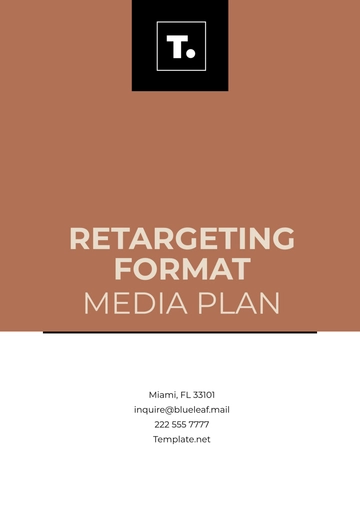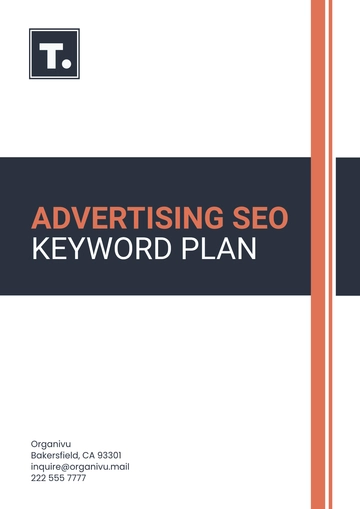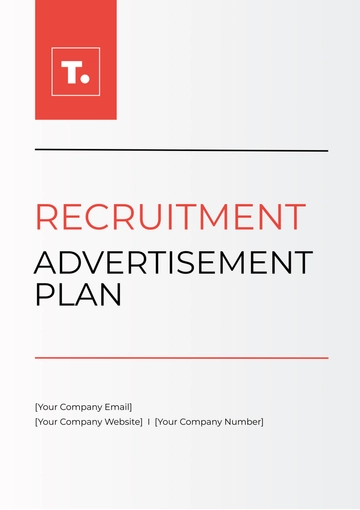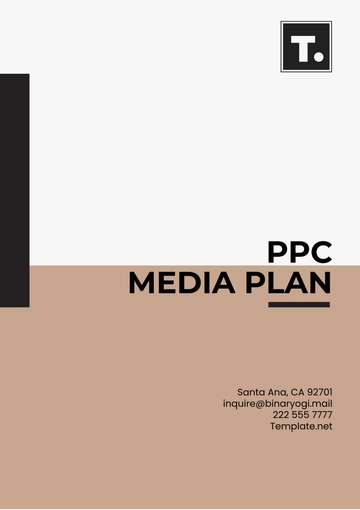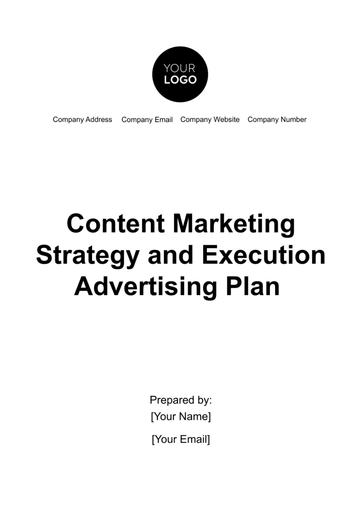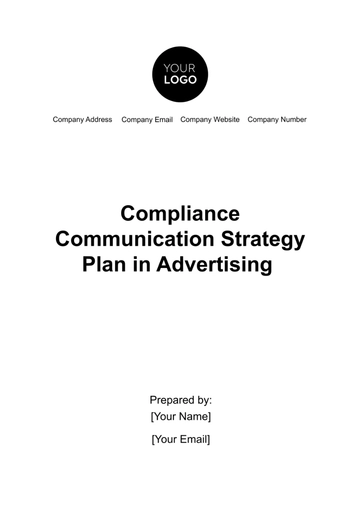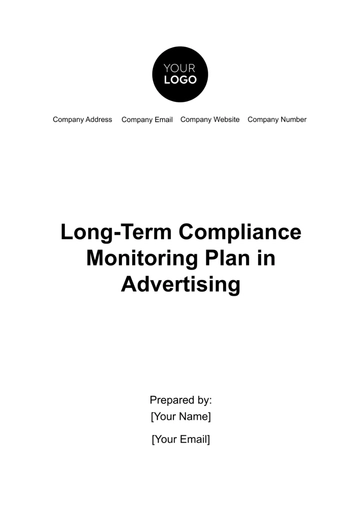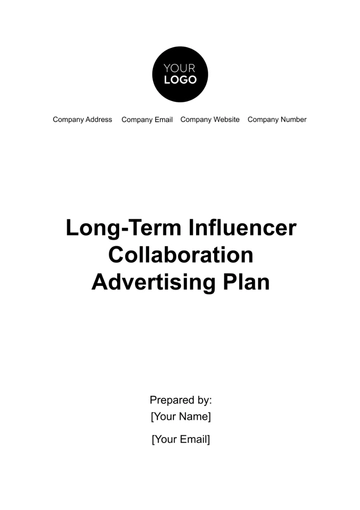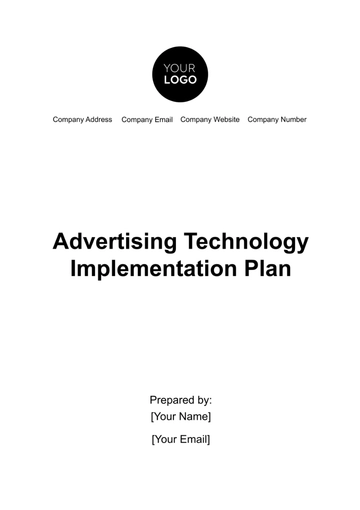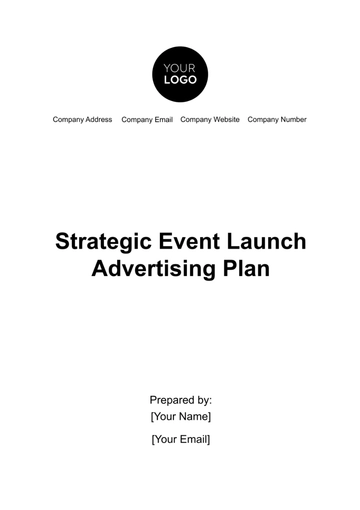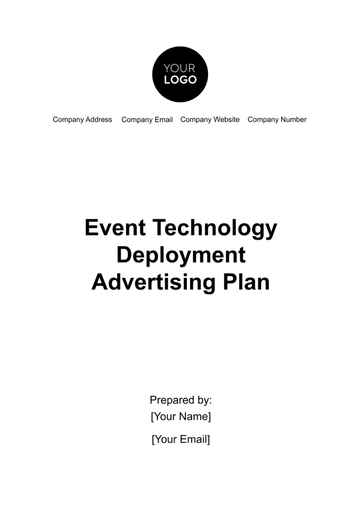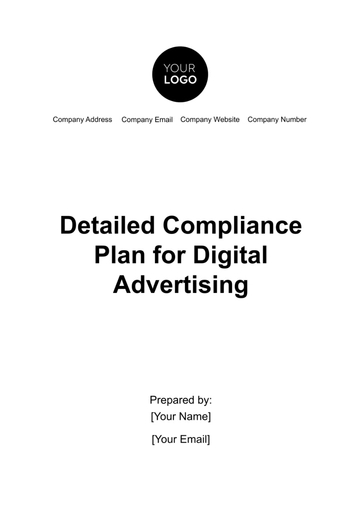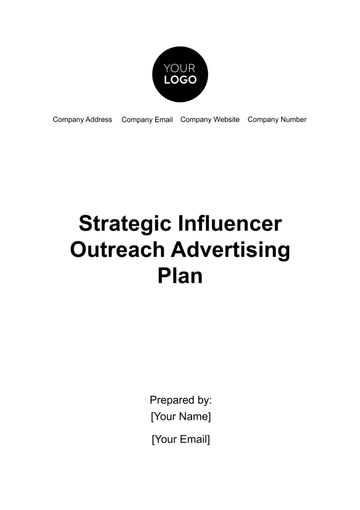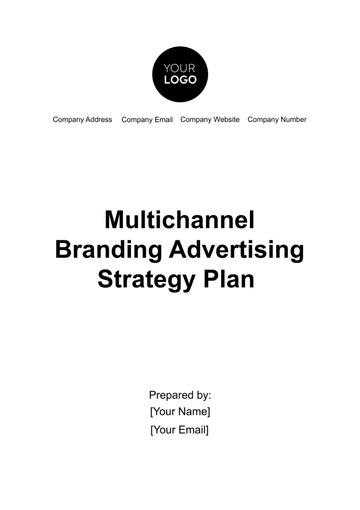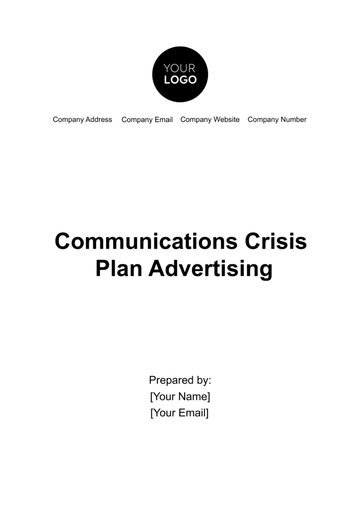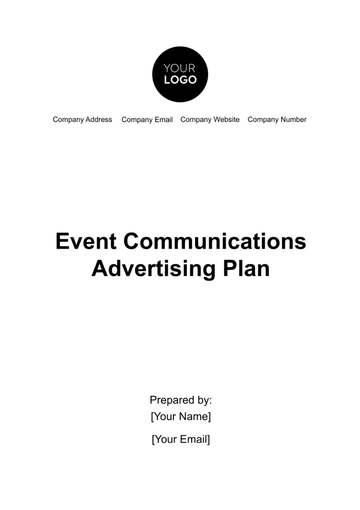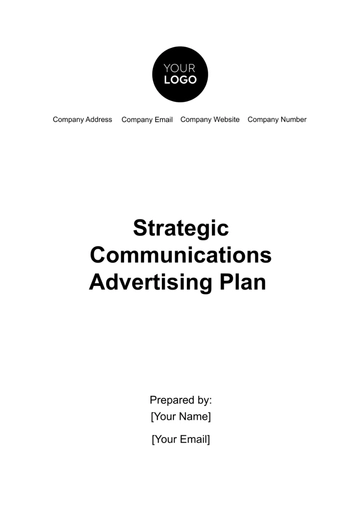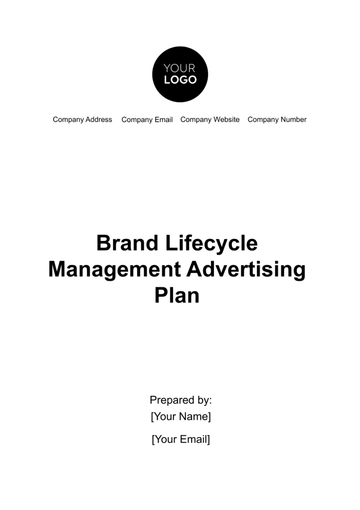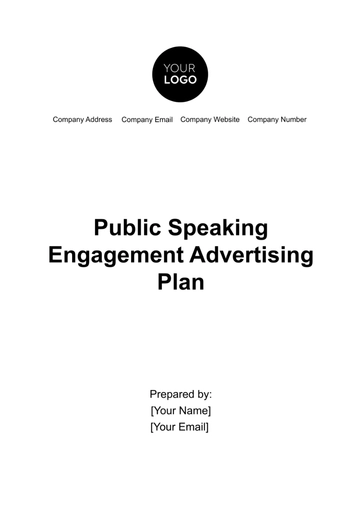Free Comprehensive Influencer Marketing Advertising Plan

I. Executive Summary
This influencer marketing advertising plan is designed to align with the company's marketing objectives, targeting key demographics through influential social media personalities. This summary provides a concise yet comprehensive overview of our strategic approach, tailored to propel [Your Company Name] to new heights in digital marketing excellence.
A. Overview of the Plan: This influencer marketing campaign, centered around [Your Company Name], aims to leverage the power of social media influencers to enhance brand visibility and engagement.
B. Objectives and Goals: The main objectives include increasing brand awareness by [30%], boosting engagement rates by [25%], and driving a [20%] increase in web traffic over the campaign period.
C. Strategic Approach: The plan will focus on collaborating with influencers who resonate with our target audience, creating authentic and compelling content that aligns with our brand values.
II. Target Audience Analysis
Understanding the target audience is crucial for an effective influencer marketing campaign. This analysis involves diving deep into the demographics, psychographics, and behavioral patterns of the audience to ensure that the influencers and content strategies align perfectly with the audience’s preferences and interests.
A. Demographics: The primary audience consists of individuals aged [25-40], predominantly urban dwellers, with an interest in our products or services.
B. Psychographics: These individuals value quality, sustainability, and innovation. They are active on social media and are influenced by authentic content that resonates with their lifestyle choices.
C. Behavioral Insights: This group frequently engages with content related to business, often participates in online discussions, and is inclined to make purchases based on influencer recommendations.
The audience analysis informs the selection of influencers and the crafting of content that will resonate with the target market. It ensures that the campaign is tailored to the preferences and behaviors of those most likely to engage with and respond to the brand’s messaging.
III. Influencer Criteria Selection
Selecting the right influencers is paramount to the success of the campaign. The criteria for selection must align with the brand’s objectives and the target audience’s preferences. It involves evaluating influencers based on their reach, relevance, engagement rates, and suitability for the brand.
A. Influencer Type: Focus on micro and macro-influencers who have a proven track record of engaging an audience similar to our target market.
B. Relevance to Brand and Audience: Influencers must have a content style and audience demographic that aligns closely with [Your Company Name]’s brand values and target audience.
C. Engagement Rates and Audience Quality: Preference for influencers with high engagement rates (likes, comments, shares) and a genuine, interactive follower base.
The selection criteria ensure that chosen influencers are not just popular but are genuinely influential among our target audience. This strategic alignment is critical for the authenticity and effectiveness of the campaign.
IV. Influencer Identification and Outreach
The process of identifying and reaching out to potential influencers is a crucial step. It involves researching to find the best fit, crafting personalized outreach strategies, and establishing clear communication guidelines to maintain brand consistency.
A. Identification Process: Utilize social media analytics tools to identify potential influencers, reviewing their content for alignment with [Your Company Name]’s brand image and messaging.
B. Outreach Strategy: Personalized messages that highlight the mutual benefit of the partnership, clearly outlining the campaign objectives and expectations.
C. Communication Guidelines: Provide influencers with a comprehensive guide on brand tone, messaging, and any specific campaign hashtags or calls to action.
Effective identification and outreach are essential for forming productive influencer partnerships. Personalized communication not only increases the chances of successful collaboration but also sets the tone for a professional and mutually beneficial relationship.
V. Campaign Concept and Content Strategy
This section outlines the direction of the campaign, types of content to be created, and the balance between creative freedom for influencers and adherence to brand guidelines. A well-defined content strategy ensures message consistency and maximizes campaign impact.
A. Campaign Theme and Messaging: The theme for [Event Name] will revolve around ["Innovation in Sustainability"]. The messaging will be tailored to highlight the unique aspects and benefits of the product/event.
B. Content Types: The campaign will include a mix of Instagram posts and stories, YouTube videos, and Twitter threads, focusing on personal experiences with the product, testimonials, and creative showcases.
C. Creative Freedom vs. Brand Guidelines: While influencers will have creative freedom to personalize their content, they must adhere to certain non-negotiables regarding brand portrayal and key messaging.
A clear content strategy ensures that all influencer content aligns with the campaign’s goals while maintaining the authenticity that makes influencer marketing so effective. Balancing creative freedom with brand guidelines is crucial for content that resonates with the audience and preserves brand identity.
VI. Budget and Compensation Structure
Budget allocation and compensation structure are critical components of an influencer marketing campaign. This section details the financial aspects of the campaign, including overall budget allocation, specific payment models for influencers, and any additional incentives or performance bonuses.
A. Budget Allocation: The total budget for the campaign is set at [$50,000], with allocations for different tiers of influencers based on their reach and engagement levels.
B. Payment Models: Influencers will be compensated through a mix of fixed payments for posts and commission-based rewards for direct conversions or affiliate sales.
C. Additional Incentives: Performance-based bonuses for achieving high engagement rates or exceptional content that goes viral.
Effective budget management and transparent compensation models are vital for maintaining healthy influencer relations and ensuring a positive return on investment. Performance-based incentives further motivate influencers to create impactful content.
VII. Implementation Timeline
A well-structured implementation timeline is crucial for the smooth execution of an influencer marketing campaign. This timeline outlines the key milestones, including campaign launch, content publication dates, and the overall duration of the campaign, ensuring that all activities are coordinated and timely.
A. Campaign Launch Date: The campaign is scheduled to kick off on [Date], with a pre-launch teaser phase beginning [one week] prior.
B. Key Milestones and Deadlines: Important dates include initial influencer outreach by [Date], content creation and approval by [Date], and mid-campaign review on [Date].
C. Duration of Campaign: The entire campaign will span over a period of [3 months], with a post-campaign analysis scheduled for [Date].
VIII. Legal and Compliance Considerations
Legal compliance and adherence to industry guidelines are non-negotiable aspects of influencer marketing. This section outlines the necessary contractual agreements with influencers and ensures that all content meets FTC guidelines and other regulatory requirements.
A. Contractual Agreements: Influencers will sign contracts outlining the terms of the partnership, content requirements, compensation details, and confidentiality clauses.
B. FTC Guidelines and Disclosure Requirements: All influencer content must adhere to FTC guidelines, including clear disclosures about the partnership to maintain transparency with their audience.
Ensuring legal compliance not only protects the brand but also upholds the integrity of the marketing campaign. Clear contractual agreements and adherence to guidelines prevent potential legal issues and maintain consumer trust.
IX. Monitoring and Measurement of Campaign
Continuous monitoring and measurement are vital to assess the effectiveness of the influencer marketing campaign. This process involves tracking various KPIs, utilizing tracking tools, and adjusting strategies based on real-time data to optimize campaign performance.
A. Key Performance Indicators (KPIs): Metrics such as engagement rates, reach, website traffic, conversion rates, and ROI will be tracked.
B. Tracking and Reporting Tools: Utilization of analytics tools to monitor performance and generate detailed reports for analysis.
C. Adjustment Strategies: Based on ongoing monitoring, strategies may be adjusted to improve performance, such as shifting focus among influencers, modifying content types, or revising messaging.
Continuous monitoring enables the identification of successful elements and areas needing improvement. This data-driven approach allows for agile adjustments, maximizing the campaign’s effectiveness and ensuring a strong ROI.
X. Post-Campaign Analysis and Reporting
Post-campaign analysis is crucial for evaluating the overall success of the influencer marketing campaign. It involves a comprehensive review of performance against the set objectives, an assessment of ROI, and gathering feedback for future improvements.
A. Performance Assessment: Analyze the campaign's performance based on the predetermined KPIs, comparing the results against the initial objectives.
B. ROI Evaluation: Calculate the return on investment to assess the financial effectiveness of the campaign, considering both direct and indirect benefits.
C. Feedback and Learnings: Gather feedback from both influencers and the target audience, and document key learnings and insights for future campaigns.
The post-campaign analysis provides valuable insights into what worked and what didn’t, informing future strategy. This reflective process is essential for continuous improvement and for maximizing the impact of subsequent influencer marketing initiatives.
XI. Long-Term Influencer Relationship Management
Building and maintaining long-term relationships with influencers is key to the sustained success of influencer marketing efforts. This section focuses on strategies for ongoing engagement with influencers, ensuring a pool of reliable and brand-aligned partners for future campaigns.
A. Relationship Building Strategies: Regular communication, providing constructive feedback, and recognizing influencers’ efforts to foster a positive and ongoing relationship.
B. Ongoing Engagement Plans: Opportunities for continued collaboration, such as involvement in future campaigns or brand ambassador roles, and keeping influencers updated about [Your Company Name]’s latest developments and offerings.
Long-term relationships with influencers lead to more authentic and effective partnerships. Investing in these relationships not only benefits current campaigns but also lays the foundation for future marketing successes.
XII. Conclusion
The approach outlined here is methodical and data-driven, ensuring that each step, from influencer selection to campaign execution and evaluation, aligns with our overarching marketing goals. This plan sets a precedent for [Your Company Name]'s future influencer marketing initiatives. It lays down a foundation for enduring influencer relationships, fostering a network of brand advocates and collaborators. As [Your Company Name] continues to grow and innovate, this influencer marketing plan will remain an integral tool in our marketing arsenal, driving us toward greater brand success and market leadership.
- 100% Customizable, free editor
- Access 1 Million+ Templates, photo’s & graphics
- Download or share as a template
- Click and replace photos, graphics, text, backgrounds
- Resize, crop, AI write & more
- Access advanced editor
Introducing Template.net's Comprehensive Influencer Marketing Advertising Plan Template. This editable and customizable tool, powered by our Ai Editor Tool, simplifies influencer marketing strategy creation. Craft tailored plans, engage influencers effectively, and amplify brand reach. Seamlessly adapt strategies to meet campaign goals. Elevate your influencer marketing efforts effortlessly with Template.net.
You may also like
- Finance Plan
- Construction Plan
- Sales Plan
- Development Plan
- Career Plan
- Budget Plan
- HR Plan
- Education Plan
- Transition Plan
- Work Plan
- Training Plan
- Communication Plan
- Operation Plan
- Health And Safety Plan
- Strategy Plan
- Professional Development Plan
- Advertising Plan
- Risk Management Plan
- Restaurant Plan
- School Plan
- Nursing Home Patient Care Plan
- Nursing Care Plan
- Plan Event
- Startup Plan
- Social Media Plan
- Staffing Plan
- Annual Plan
- Content Plan
- Payment Plan
- Implementation Plan
- Hotel Plan
- Workout Plan
- Accounting Plan
- Campaign Plan
- Essay Plan
- 30 60 90 Day Plan
- Research Plan
- Recruitment Plan
- 90 Day Plan
- Quarterly Plan
- Emergency Plan
- 5 Year Plan
- Gym Plan
- Personal Plan
- IT and Software Plan
- Treatment Plan
- Real Estate Plan
- Law Firm Plan
- Healthcare Plan
- Improvement Plan
- Media Plan
- 5 Year Business Plan
- Learning Plan
- Marketing Campaign Plan
- Travel Agency Plan
- Cleaning Services Plan
- Interior Design Plan
- Performance Plan
- PR Plan
- Birth Plan
- Life Plan
- SEO Plan
- Disaster Recovery Plan
- Continuity Plan
- Launch Plan
- Legal Plan
- Behavior Plan
- Performance Improvement Plan
- Salon Plan
- Security Plan
- Security Management Plan
- Employee Development Plan
- Quality Plan
- Service Improvement Plan
- Growth Plan
- Incident Response Plan
- Basketball Plan
- Emergency Action Plan
- Product Launch Plan
- Spa Plan
- Employee Training Plan
- Data Analysis Plan
- Employee Action Plan
- Territory Plan
- Audit Plan
- Classroom Plan
- Activity Plan
- Parenting Plan
- Care Plan
- Project Execution Plan
- Exercise Plan
- Internship Plan
- Software Development Plan
- Continuous Improvement Plan
- Leave Plan
- 90 Day Sales Plan
- Advertising Agency Plan
- Employee Transition Plan
- Smart Action Plan
- Workplace Safety Plan
- Behavior Change Plan
- Contingency Plan
- Continuity of Operations Plan
- Health Plan
- Quality Control Plan
- Self Plan
- Sports Development Plan
- Change Management Plan
- Ecommerce Plan
- Personal Financial Plan
- Process Improvement Plan
- 30-60-90 Day Sales Plan
- Crisis Management Plan
- Engagement Plan
- Execution Plan
- Pandemic Plan
- Quality Assurance Plan
- Service Continuity Plan
- Agile Project Plan
- Fundraising Plan
- Job Transition Plan
- Asset Maintenance Plan
- Maintenance Plan
- Software Test Plan
- Staff Training and Development Plan
- 3 Year Plan
- Brand Activation Plan
- Release Plan
- Resource Plan
- Risk Mitigation Plan
- Teacher Plan
- 30 60 90 Day Plan for New Manager
- Food Safety Plan
- Food Truck Plan
- Hiring Plan
- Quality Management Plan
- Wellness Plan
- Behavior Intervention Plan
- Bonus Plan
- Investment Plan
- Maternity Leave Plan
- Pandemic Response Plan
- Succession Planning
- Coaching Plan
- Configuration Management Plan
- Remote Work Plan
- Self Care Plan
- Teaching Plan
- 100-Day Plan
- HACCP Plan
- Student Plan
- Sustainability Plan
- 30 60 90 Day Plan for Interview
- Access Plan
- Site Specific Safety Plan

